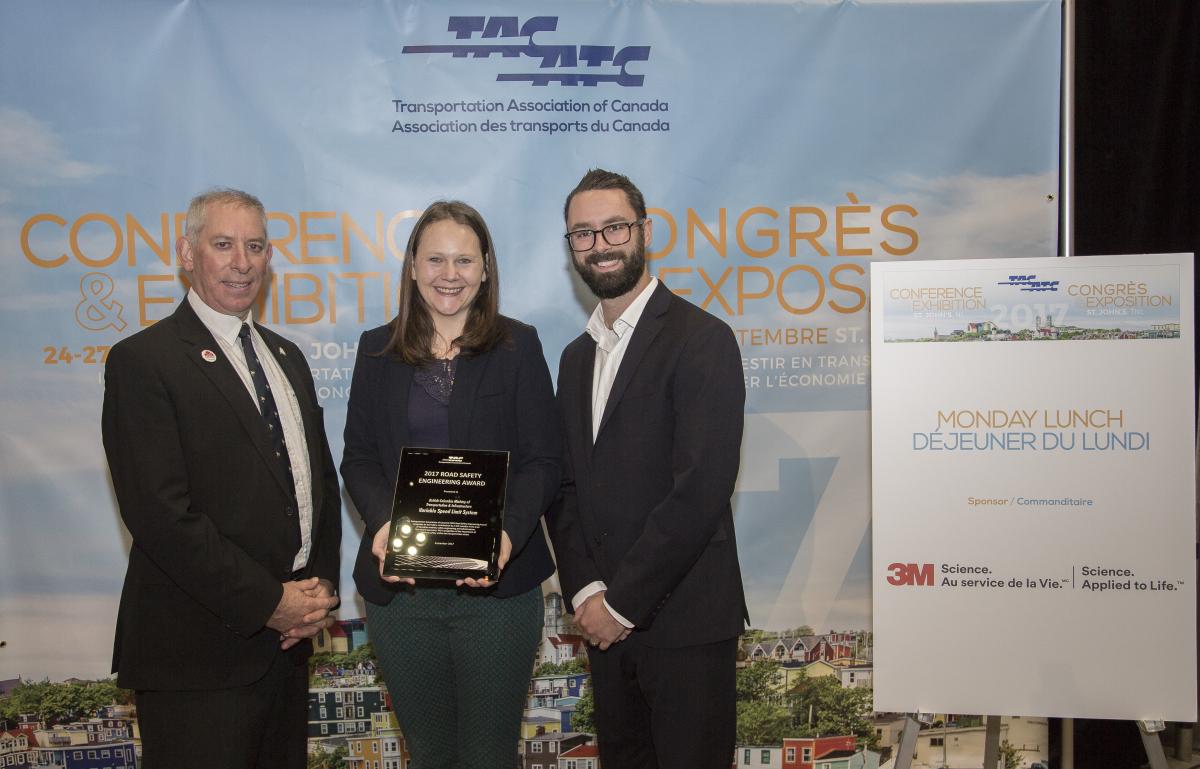The winner of the Transportation Association of Canada (TAC) 2017 Road Safety Engineering Award is British Columbia Transportation and Infrastructure for Variable Speed Limit System.
This award recognizes exemplary contributions by a TAC member organization in Canadian roadway safety engineering and infrastructure. It also encourages the development and implementation of roadway safety countermeasures, guidelines and safety management systems for roadway design and operations.

Winner of the TAC Road Safety Engineering Award: Kenedee Ludwar, BC Transportation and Infrastructure (centre); Paul Lafleche, TAC President (left); Don Boccabella, 3M Canada (right).
British Columbia Transportation and Infrastructure recognized that there was a need to develop a system that provided a reliable driving experience during adverse weather conditions to address driver error, distraction and speeding.
 As part of the commitment to invest in a new road safety improvement program, the Ministry designed, constructed and implemented a variable speed limit (VSL) system on three corridors in British Columbia that experience rapidly changing weather conditions.
As part of the commitment to invest in a new road safety improvement program, the Ministry designed, constructed and implemented a variable speed limit (VSL) system on three corridors in British Columbia that experience rapidly changing weather conditions.
“These corridors were noted as having severe winter weather conditions, high elevation changes, and poor road safety performance during winter conditions,” explains Jennifer Locke, Project Manager, BC Transportation and Infrastructure. “The variable speed limit systems were implemented on Highway 5 the Coquihalla, through Snowshed Hill, along Highway 99 between Squamish and Whistler, and on Highway 1 from Sicamous to Revelstoke.”
Design of the VSL system took place through 2015 and was activated in June 2016. This joint effort by the Ministry of Transportation and Infrastructure, IBI Group and PBX Engineering implemented a system with 47 overhead LED variable speed limit signs, equipped with yellow amber flashers that activate when a reduced speed limit is in place. Overhead digital message signs at the beginning of each corridor alert drivers to upcoming weather or road events which have triggered a speed limit reduction.
The VSL system the Ministry has developed uses roadside-collected data on weather, surface condition, and vehicle speed to recommend a speed limit based on current conditions. Variable speed limits were implemented to provide a more reliable driving experience by using real-time road condition information.
BC Ministry staff have had an opportunity to monitor the changing driver behaviours over the course of this first winter season.
“Based on collected data, it is observed drivers are reducing their speeds on variable speed corridors when a lowered speed limit is posted,” adds Jennifer. “The data is showing a reduction in driver’s 85th percentile speeds, specifically during winter events. Between December 23 and 30, 2016, BC experienced a severe snow event that impacted all three corridors. Analysis of the posted speeds, 85th percentile and precipitation on the corridors showed that drivers responded positively to the system and lowered their driving speeds.”
The recommended speed limit provides a safer and more reliable journey through mountainous corridors. The Ministry is continuing to monitor the corridors that have VSLs in place to determine the extent of safety benefits to road users.
“The technology used in the VSL system would be beneficial to any jurisdiction that has rapidly changing weather conditions. The Ministry is currently employing VSL technology and applying it in a congested corridor to improve traffic flow during peak hours.”
One other submission for TAC’s 2017 Road Safety Engineering Award was also received: City Centre Cycle Track (Urban Systems).
The award will be presented at the 2017 TAC Conference & Exhibition in St. John’s on September 25.